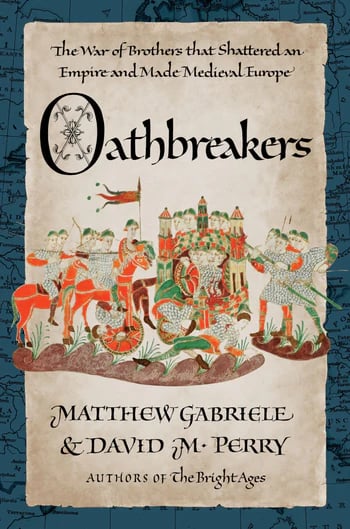"How did everyone know where to go for the battle in the Middle Ages?"
A really good question from a viral Tiktok that's kind of answered in our new book

Modern Medieval
by David M. Perry and Matthew Gabriele
One of the viral things going around is this video from Tiktok:
@indipine i filmed this at 2am and it kept me up all night #historytok #medieval #medievaltiktok #middleages #battlefield #historytime ♬ Medieval Times - Daniel Summer
The question she asks is a really good one! How did medieval armies find each other? In a world before GPS, without modern infrastructure (roads) and primarily consisting of wilderness and farmland, how did they know where to go and even if they should go out and find someone to fight?
Conveniently, we have a book coming out that answers those questions! Sometimes: they knew where to go because both sides wanted a battle. Other times: chance, incompetence, or great scouting brought forces together, often resulting in great victories or disasters (depending on one’s perspective).

Oathbreakers is about a civil war fought among brothers, but culminates in one violent battle that becomes a massacre. Throughout the 830s, these petty kings (and their father, the emperor) would put big armies into the field then chase each other around - intentionally avoiding fighting.
But then the father died in 840 and all hell broke loose.
In early 841, 2 major battles occurred - one by accident and one absolutely on purpose.
So, to answer the original question posed by @indipine on Tiktok, many medieval battles happened because they were planned in advance. It took lots of time to raise an army in the European Middle Ages, because there was really no such thing as a standing army. Kings and great nobles would have armed household guards who would travel with them, or members of their court (who would also be armed nobles and sometimes have their own armed followers), but a general levy would need to be summoned from across vast distances and without the benefit of instantaneous communication. Each levy would be led by its own commander, be it abbot, bishop, count, baron, etc. This was a noisy, cumbersome task and needed time and planning not just to raise the army but to provision it!
Once those armies were in the field though, battles usually only happened when both leaders WANTED the battle to happen. Almost always (see below for why not just “always”) armies were good about sending out scouts and knowing where the enemy was because armies moved slowly by foot and horse and often across open ground, or following old Roman roads. They had to camp at night and light fires.
So, if both sides wanted battle, they’d often exchange messengers and set up camp a few miles from one another. They’d conduct diplomacy and agree on a time/ date for the battle then march out and meet one another. The climactic battle of Fontenoy in June 841 in Oathbreakers followed this pattern. When diplomacy failed, they agreed to meet on in battle between the armies’ camps at dawn on a Saturday morning - and that’s what they did.
But sometimes one side didn’t want to fight. Usually when that happened, there was no battle, because it’s much easier to avoid conflict than to chase an enemy down. In Oathbreakers, we talk about how, for nearly 3 years Louis the German (the middle son in the civil war among brothers) was chased around East Francia first by his father and then by his elder brother and his army. They didn’t fight, in large part, because they kept on separate sides of the Rhine but also because a pitched battle was high risk/ high reward. You risked everything, so it was best avoided unless you were either (a) sure you’d win, or (b) desperate.
In early 841, Louis the German got desperate. And then he got lucky. His opponent, Duke Adalbert of Metz (who was in command of an army on behalf of the current emperor, Louis’ elder brother), was shadowing Louis’ forces and decided - on Friday the 13th (May 13, 841) - to cross the Wornitz River.
Louis’ forces were waiting. His archers let fly. His infantry and cavalry charged. Adalbert was killed, his army scattered. Louis’ men plundered the fallen and started a hard march west to meet up with their ally, the youngest brother Charles, and prepare for what became the Battle of Fontenoy.
Part of this is about knowing where to fight because of terrain. Rivers (and forests, but less so) were areas of both danger and opportunity. If you could cross a river quickly and safely, either by fording or via a bridge, you could show up somewhere your enemy didn’t expect and get the drop on them. But the enemy knew that and so would usually watch the crossing spots. If they could catch you during the river crossing, you were in deep, deep, deep, deep trouble. They could pick you off in the river, cause your troops and horses to panic and so drown your troops, or hit you just as you crossed, pinning you down with nowhere to retreat. This would become a route, sometimes a massacre - and it happens several times in our book, but never with more consequence than when Louis defeats Adalbert.
So we have battles that happen in places that mattered, and we have battles in places that didn’t matter (like Fontenoy) but where the sides pre-negotiated combat.
But mostly, Carolingian nobles liked to raise armies, march towards battle shouting how eager they were to fight, and then not fight. They liked to plan for every contingency. But when those contingencies failed, when the exceptions to the expectations emerged, battle could suddenly - unexpectedly - be joined and, as we discuss in Oathbreakers, shatter an empire.